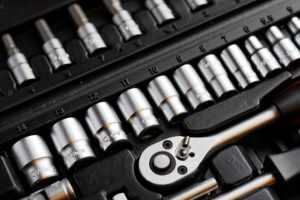By Dr. Jody Muelaner

A socket attaches to a turning tool to tighten or loosen fasteners, such as a nut or bolt. Sockets are typically sold in sets with a drive tool.
Sockets are tools used to tighten mechanical fasteners. They fit over the head of the fastener to provide torque. Typically, sockets have a hexagonal hole at one end that’s designed to fit over a hex head bolt or screw. On the other end of the socket is a square hole that fits over the square drive of a socket wrench.
However, the term socket also refers to a hole designed to accept some other part. For example, a mechanical fastener may include a socket in its head that accepts a male tool.
Tool sockets
A socket is a cylindrical tool with a different shaped socket at each end. At one end there’s a prismatic hole that fits over the head of a fastener. This hole is most commonly hexagonal to fit the head of a hex-head bolt or hexagonal nut. However, several types of sockets are available to fit a variety of fasteners.
On the opposite end of the socket is a square hole that engages with another tool to drive the socket. The square drive is either 1/4, 3/8, 1/2 or 3/4-in. Metric sockets still use these sizes for the drive.
Sockets are unable to generate torque alone. Rather, they provide an interface between a torque generating tool or driver and the fastener. Examples of tools used to drive sockets are wrenches (including socket, pneumatic impact, and hydraulic torque wrenches), as well as torque multipliers and breaker bars.
One advantage of sockets is that a single driver can be used for several different sizes and types of fasteners. This includes short, long, and narrow sockets that reach various workspaces. Standard sockets are designed to fit over fasteners with good access and offer strength to apply significant torque. These tools can also drive hex tools or male bits, which fit into socket head fasteners.
What’s more is that sockets are typically less costly and require less space than spanners. Also, if necessary, an extension bar can be used to access hard-to-reach fasteners, which is not an option with spanners. Sets are available that offer a large selection of sockets and male bits with drive tools.
Fastener sockets
Fasteners may have sockets within their heads through which torque is applied. Socket fasteners include screws, set screws, bolts, and shoulder bolts.
A few common socket shapes used in the heads of such fasteners include:
- · Cross, Philips, or Pozidriv. Cross-shaped holes that taper toward a point at the bottom, these sockets are used for wood and self-tapping screws, or small countersunk machine screws.
- · Hexagon socket. A prismatic hexagonal hole that’s mostly used in machine screws, such as socket head cap screws.
- · Slot or flat head. A rectangular slot that runs the length of the head and is typically found on wood screws
- · Socket bits. A combination of a screwdriver bit and a hex socket that can be made of one solid piece of metal or two separate parts that are fixed together.
- · Torx. A six-pointed star that’s typically used in machine screws for the automotive and consumer goods industries.





Tell Us What You Think!